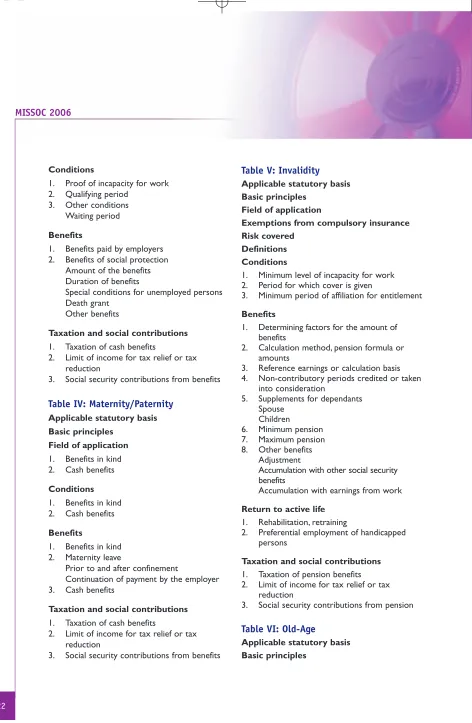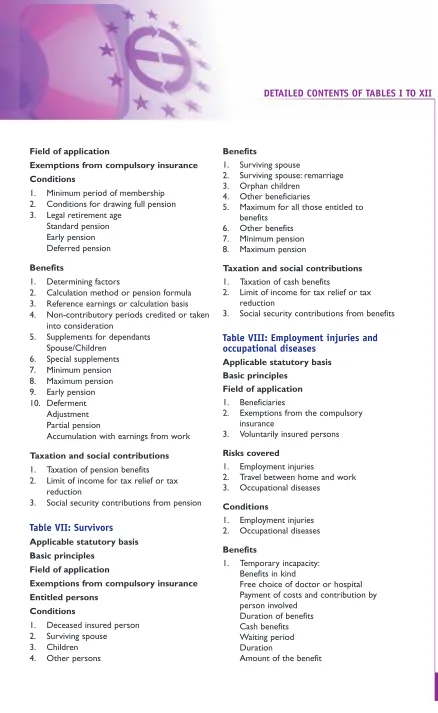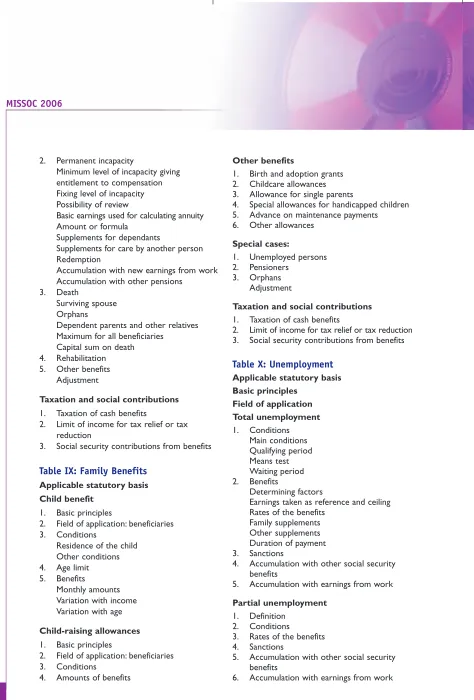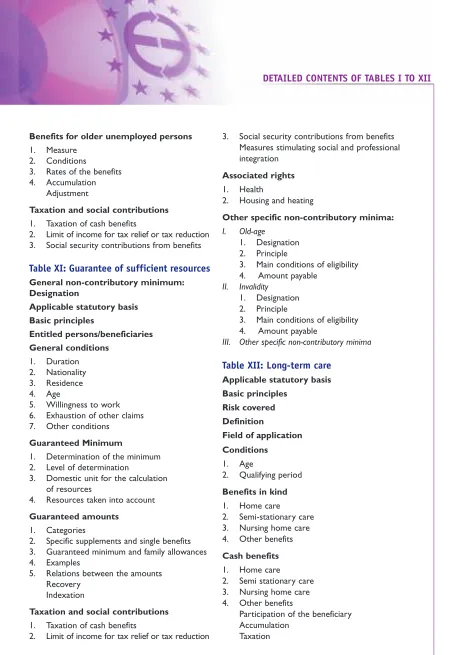European Commission
MISSOC 2006
Mutual Information System on Social Protection
Social Protection in the Member States of the European
Union, the European Economic Area and in Switzerland
MISSOC 2006
Mutual Information System on Social Protection
Social Protection in the Member States of the European Union,
the European Economic Area and in Switzerland
Situation on 1st
The contents of this publication do not necessarily reflect the opinion or position of the European Commission, Directorate-General for Employment, Social Affairs and Equal Opportunities.
If you are interested in receiving the electronic newsletter ‘ESmail’ from the European Commission’s Directorate-General for Employment, Social Affairs and Equal Opportunities, please send an e-mail to empl-esmail@ec.europa.eu. The newsletter is published on a regu-lar basis in English, French and German.
A great deal of additional information on the European Union is available on the Internet. It can be accessed through the Europa server (http://europa.eu).
Cataloguing data can be found at the end of this publication.
Luxembourg: Office for Official Publications of the European Communities, 2007
© European Communities, 2007
Reproduction is authorised provided the source is acknowledged.
Printed in Belgium
PRINTED ON WHITE CHLORINE-FREE PAPER
Europe Direct is a service to help you find answers to your questions about the European Union
Freephone number (*):
00 800 6 7 8 9 10 11
(*) Certain mobile telephone operators do not allow access to 00 800 numbers or these calls may be billed.
TABLE OF CONTENTS
Table of contents
MISSOC 2006 CD 5
WHAT IS MISSOC? 5
MISSOC PRODUCTS 7
1. MISSOC comparative tables 7
2. The organisation of social protection 8
3. The social protection of the self-employed 8
4. MISSOC Info Bulletins 9
5. The MISSOC web pages on the Europa website 9
HOW TO NAVIGATE IN THE CD-ROM 11
1. Navigation in the comparative tables on social protection 13
a. Country selection 13
b. Subject selection 14
c. Create the comparative table 15
d. Printing 16
2. Navigation in the sections on the organisation of social protection, the social protection of the self-employed, the MISSOC Info Bulletins
and MISSOC 2006 in PDF format 17
MISSOC CD-ROM – TROUBLESHOOTING 19
DETAILED CONTENTS OF TABLES I TO XII 21
MISSOC CORRESPONDENTS AND SECRETARIAT 27
FEEDBACK
MISSOC 2006 CD
MISSOC 2006 CD
The CD-ROM attached to this publication (on the inside of the back cover) contains the MIS-SOC comparative tables on European social protection systems in an interactive web page format as well as in a PDF version. It also includes descriptive information about the organi-sational structure of social protection in each country and the social protection systems for the self-employed. Detailed instructions on navigation through the CD-ROM are provided later in this booklet.
WHAT IS MISSOC?
The Mutual Information System on Social Protection (MISSOC) was established in 1990 by the European Commission as an instrument to facilitate the continuous and comprehensive exchange of information on social protection between the EU Member States. MISSOC has since been further developed and has become an important central source of information on social protection in all Member States of the European Union.Today the information system includes the 25 Member States, the three countries of the European Economic Area – Iceland, Liechtenstein, Norway – and Switzerland.
MISSOC is based on a close cooperation between the European Commission, the network of the official representatives of the participating countries and the secretariat appointed by the European Commission. The coordination of MISSOC is administered by the European Commission, Directorate-General for Employment, Social Affairs and Equal Opportunities.
To ensure the reliability of information published by MISSOC, each participating country is represented by correspondents from the national ministries or institutions that are respon-sible for the areas of social protection.The MISSOC correspondents for 2006 are presented in the section ‘MISSOC CORRESPONDENTS AND SECRETARIAT’.
The MISSOC secretariat, appointed by the European Commission, is responsible for the ongoing coordination of the network and the preparation of its publications.These tasks are currently being carried out by the Otto-Blume-Institut für Sozialforschung und Gesellschaftspolitik (ISG) e.V., Cologne, Germany.
MISSOC PRODUCTS
MISSOC PRODUCTS
The MISSOC network produces regularly updated information on all areas of social protec-tion. The correspondents provide information according to agreements made at the two annual plenary meetings.The information is then collated to produce the following products:
1. The MISSOC comparative tables (database and PDF-format)
2. The organisation of social protection – charts and descriptions
3. The social protection of the self-employed
4. The MISSOC Info Bulletins
5. The MISSOC website hosted on the EUROPA server.
All these products are made in three languages (German, English and French).
To facilitate comparisons, the monetary amounts in each product are shown in Euros and in the national currency in the case of countries outside the Euro zone. As a basis for calcula-tion, the official exchange rate from 2nd of January 2006 is used.
1. MISSOC comparative tables
The MISSOC comparative tables on social protection are published once a year showing the information valid as of the 1stof January that year.
[image:8.584.45.297.35.155.2]They contain a detailed presentation of the statutory regulations regarding the core areas of social protection in the form of twelve tables, which also allow a comparison between differ-ent countries.
Table Iaddresses the central aspects of financing social protection:
a) The financing principles for the individual areas of social protection,
b) The contribution of insured persons and their employer,
c) The public authorities participation in financing, and
Tables II-XIIcover the most important categories of social protection: health care, cash and non-cash benefits during illness, maternity and disability, benefits for the elderly and the bereaved, benefits for occupational injuries and diseases, family benefits, unemployment bene-fits, minimum protection and long-term care benefits.
The detailed list of the 306 categories dealt with throughout the twelve tables is presented at the end of this leaflet.
The purpose of these tables and categories is to provide an overview of the main character-istics of the different legislations and to enable a comparison. To facilitate access to further sources for more detailed information, a notation to the respective law is given in the lan-guage of the country.
MISSOC information is mainly limited to general statutory systems of social protection, which – depending upon country and area of protection – are either universal systems cov-ering the entire population, or employment-related systems protecting the ‘active’ population (i.e. the employed and the self-employed), or systems applying solely to employees. The scope of the general systems is, as a rule, limited to the statutory basic protection of the so-called ‘first pillar’. Supplementary systems of the second and third pillars, based on voluntary mem-bership or on collective agreements, are not generally covered by MISSOC.
As a rule, the specific social protection of civil servants is not covered in the Tables. The social protection of the self-employed is only covered in Tables I-XII if they are a part of the ‘gen-eral system’. Other systems for the self-employed are covered separately – see below.
2. The organisation of social protection
The social protection organisation structure of each of the 29 countries covered by MISSOC is illustrated in an organisation chart and described in a brief text. For quick access to fur-ther information, the text also contains the Internet addresses of the Ministries responsible for social protection as well as the other relevant institutions.
3. The social protection of the self-employed
Because of the many different social protection systems for the self-employed that exist in several countries, the coverage in this section has had to be limited. For all those countries where there is no uniform system of social protection of the self-employed, the information is restricted to the basic groups of self-employed farmers, handcrafts men and tradesmen. Specific schemes for members of the classic ‘liberal professions’ are not currently included.
8
MISSOC PRODUCTS
4. MISSOC Info Bulletins
MISSOC Info Bulletins are complementary to the comparative tables, providing more descrip-tive and comprehensive information in a broader perspecdescrip-tive.The MISSOC Info Bulletins con-sist of an introduction written by the secretariat’s experts that summarises the overall major trends, followed by the individual national reports prepared by the correspondents.They are usually produced twice a year.
(1) The first annual issue is dedicated to a description of the main developments of social protection during the preceding year, in the 25 EU Member States, the EEA countries and Switzerland.
(2) The second annual issue covers a specific topic of social protection. Several areas of social protection have been described in recent years, in line with the social policy con-cerns at European level.
5. The MISSOC web pages on the Europa website:
http://www.ec.europa.eu/employment_social/social_protection/missoc_en.htm
The MISSOC web pages contain the current MISSOC comparative tables, including the descriptions of the organisation of the national social protection systems and the social pro-tection of the self-employed, as well as the archives for the earlier years (PDF files).The MIS-SOC Info Bulletins can also be found here in chronological order, in PDF format.
HOW TO NAVIGATE IN THE CD-ROM
HOW TO NAVIGATE IN THE CD-ROM
The attached CD-ROM contains the MISSOC products presented above, that is:
• The MISSOC comparative tables as of 1stof January 2006,
• The organisational charts and descriptive text,
• The social protection of the self-employed, and
• The MISSOC Info Bulletins (from 2004 to 2006).
For ease of use they are all integrated into one application, which can be operated like a stan-dard interactive page on the Internet.
After introducing the CD-ROM into the CD-reader of your PC, the MISSOC application will automatically start with your web browser (Microsoft Windows Internet Explorer™, Netscape Navigator™ or another browser) and the starting page (the ‘Index page’) will be displayed on the screen. If it does not appear automatically, go into "My Computer" on your desktop and double-click on the file "MISSOC 2006". If this does not work, please look at the section on ‘Troubleshooting’ in this booklet. Before removing the CD-ROM from the reader, please close the MISSOC application.
The information is presented in three languages: German, English and French.You can choose one language by clicking on the corresponding welcome message.You can switch languages at any time throughout the whole application.
12
MISSOC 2006
When you click on the welcome message in the language you select, the following ‘Information choice’ page will appear on your screen.
This page shows the table of contents of the CD-ROM:
The MISSOC-header
Shortcuts to the three languages A text-line indicates the level you are
at within the application.To go back to the previous level, click on one of the underlined pages on the text-line
An introduction to MISSOC Five boxes with links
HOW TO NAVIGATE IN THE CD-ROM
1. Navigation in the comparative tables on social protection
The database is an ‘interactive’ file, which allows and requires your active selection of the information you want to view, both in terms of country selection and by subject.
a. Country selection
A list of countries appears in the top horizontal white window with a scroll bar on the right.
• You can scroll up or down to select a single country by directly clicking on its name, which will then be highlighted, or
• You can select several countries in order to compare them.To do this, click their names in the list while keeping the ‘Ctrl’-Button pressed on your keyboard. A second click on a highlighted country will annul that selection.
All highlighted countries will be shown in the comparative table that will be created. The first box contains the link to the ‘Comparative tables on social protection’ in a database format that allows free selection of what data and countries to look at.
The second box contains the link to the ‘Organisation of social protection: charts and descriptions’.
The third has the link to the ‘Social protection of the self-employed’.
The fourth is the link to the ‘MISSOC Info Bulletins’.
The fifth box links to some of the MISSOC products in PDF version, including the complete comparative tables in a printable PDF version.
14
MISSOC 2006
b. Subject selection
Below the list of countries are two further white windows. The one on the left (called ‘Choose topics’) contains all topics covered in the tables. To select the topics, double click on each topic of interest and these will appear in the window on the right (‘Topics to be com-pared’). Double-clicking on a topic in this window will remove the topic, thus annulling your previous choice. Information about all the topics shown in the window on the right will be presented in the comparative table that will be created.
HOW TO NAVIGATE IN THE CD-ROM
c. Create the comparative table
After completing the country and subject selections, simply click on the button ‘compare’ in the middle of the page on the right hand side. The process of compiling the comparative table may take a few moments, depending on how many countries and/or topics you have chosen to compare. The result will look like the image below.
MISSOC 2006
16
To print out several countries on the same page, please select the ‘Information choice’ page, and click on ‘MISSOC 2006 in PDF format’ in the white window, where there are more print-ing possibilities.
d. Printing
HOW TO NAVIGATE IN THE CD-ROM
The pages with the description and the chart of the organisation of social protection in the selected country appear as shown on page 18, in PDF format (please note that it is not
pos-2. Navigation in the sections on the organisation of social protection,
the social protection of the self-employed, the MISSOC Info Bulletins
and MISSOC 2006 in PDF format
As mentioned above, the ‘Information choice’ page shows white boxes with links to the above-mentioned sections with documents (these documents are PDF files, which require the use of the Adobe Acrobat Reader™ programme).To explain the navigation in these sec-tions, we will open the document on the organisation of social protection in Malta, as an example.
After clicking on the link to ‘Organisation of social protection’ displayed on the ‘Information choice’ page, the following appears on the screen:
The white window contains a list of countries, which you can scroll through by clicking on the small black arrow in the grey area beside the country name.
After choosing the entry ‘Malta’, click on the button ‘download/view’.
MISSOC 2006
MISSOC CD-ROM – TROUBLESHOOTING
MISSOC CD-ROM – TROUBLESHOOTING
When using the MISSOC CD-ROM some problems may occur.
If the application does not start automatically or the contents do not appear, it may be because:
1. The application needs the interpretation of ‘javascript’ to be activated in your Internet browser.
2. Firewalls installed on your computer must be enabled to allow the application to work.
If the application does not start automatically after you insert the CD-ROM in the appropri-ate drive, please open the contents of the CD-ROM in your Windows explorer function and double-click on the file ‘missoc.exe’.
DETAILED CONTENTS OF TABLES I TO XII
[image:22.584.65.500.29.664.2]DETAILED CONTENTS
OF TABLES I TO XII
Table I: Financing
Financing principle
1. Sickness and maternity: Benefits in kind
2. Sickness and maternity: Cash benefits
3. Long-term care
4. Invalidity
5. Old-age
6. Survivors
7. Employment injuries and occupational
diseases
8. Unemployment
9. Family allowances
Contributions of insured and employers Rates and ceiling
1. Overall contributions
2. Sickness and maternity: Benefits in kind
3. Sickness and maternity: Cash benefits
4. Long-term care
5. Invalidity
6. Old-age
7. Survivors
8. Employment injuries and occupational
diseases
9. Unemployment
10. Family allowances
11. Other special contributions
Public authorities’ participation
1. Sickness and maternity: Benefits in kind
2. Sickness and maternity: Cash benefits
3. Long-term care
4. Invalidity
5. Old-age
6. Survivors
7. Employment injuries and occupational
[image:22.584.44.294.33.155.2]diseases
Table II: Health care
Applicable statutory basis Basic principles
Field of application
1. Beneficiaries
2. Exemptions from the compulsory insurance
3. Voluntarily insured persons
4. Eligible dependants
Conditions
1. Qualifying period
2. Duration of benefits
Organisation 1. Doctors: Approval Remuneration 2. Hospitals Benefits
1. Medical treatment:
Choice of doctor Access to specialists Payment of doctor Patient’s participation
Exemption or reduction of patient's participation
2. Hospitalisation:
Choice of hospital Patient's participation
Exemption or reduction of patient's participation
3. Dental care:
Treatment Dental prosthesis
4. Pharmaceutical products
5. Prosthesis, spectacles, hearing-aids
6. Other benefits
22
MISSOC 2006
Conditions
1. Proof of incapacity for work
2. Qualifying period
3. Other conditions
Waiting period
Benefits
1. Benefits paid by employers
2. Benefits of social protection
Amount of the benefits Duration of benefits
Special conditions for unemployed persons Death grant
Other benefits
Taxation and social contributions
1. Taxation of cash benefits
2. Limit of income for tax relief or tax
reduction
3. Social security contributions from benefits
Table IV: Maternity/Paternity
Applicable statutory basis Basic principles
Field of application
1. Benefits in kind
2. Cash benefits
Conditions
1. Benefits in kind
2. Cash benefits
Benefits
1. Benefits in kind
2. Maternity leave
Prior to and after confinement
Continuation of payment by the employer
3. Cash benefits
Taxation and social contributions
1. Taxation of cash benefits
2. Limit of income for tax relief or tax
reduction
3. Social security contributions from benefits
Table V: Invalidity
Applicable statutory basis Basic principles
Field of application
Exemptions from compulsory insurance Risk covered
Definitions Conditions
1. Minimum level of incapacity for work
2. Period for which cover is given
3. Minimum period of affiliation for entitlement
Benefits
1. Determining factors for the amount of
benefits
2. Calculation method, pension formula or
amounts
3. Reference earnings or calculation basis
4. Non-contributory periods credited or taken
into consideration
5. Supplements for dependants
Spouse Children
6. Minimum pension
7. Maximum pension
8. Other benefits
Adjustment
Accumulation with other social security benefits
Accumulation with earnings from work
Return to active life
1. Rehabilitation, retraining
2. Preferential employment of handicapped
persons
Taxation and social contributions
1. Taxation of pension benefits
2. Limit of income for tax relief or tax
reduction
[image:23.584.70.542.18.741.2]3. Social security contributions from pension
Table VI: Old-Age
DETAILED CONTENTS OF TABLES I TO XII
Field of application
Exemptions from compulsory insurance Conditions
1. Minimum period of membership
2. Conditions for drawing full pension
3. Legal retirement age
Standard pension Early pension Deferred pension
Benefits
1. Determining factors
2. Calculation method or pension formula
3. Reference earnings or calculation basis
4. Non-contributory periods credited or taken
into consideration
5. Supplements for dependants
Spouse/Children
6. Special supplements
7. Minimum pension
8. Maximum pension
9. Early pension
10. Deferment Adjustment Partial pension
Accumulation with earnings from work
Taxation and social contributions
1. Taxation of pension benefits
2. Limit of income for tax relief or tax
reduction
[image:24.584.33.292.34.154.2]3. Social security contributions from pension
Table VII: Survivors
Applicable statutory basis Basic principles
Field of application
Benefits
1. Surviving spouse
2. Surviving spouse: remarriage
3. Orphan children
4. Other beneficiaries
5. Maximum for all those entitled to
benefits
6. Other benefits
7. Minimum pension
8. Maximum pension
Taxation and social contributions
1. Taxation of cash benefits
2. Limit of income for tax relief or tax
reduction
3. Social security contributions from benefits
Table VIII: Employment injuries and occupational diseases
Applicable statutory basis Basic principles
Field of application
1. Beneficiaries
2. Exemptions from the compulsory
insurance
3. Voluntarily insured persons
Risks covered
1. Employment injuries
2. Travel between home and work
3. Occupational diseases
Conditions
1. Employment injuries
2. Occupational diseases
Benefits
1. Temporary incapacity:
Benefits in kind
[image:24.584.64.502.37.750.2]24
MISSOC 2006
2. Permanent incapacity
Minimum level of incapacity giving entitlement to compensation Fixing level of incapacity Possibility of review
Basic earnings used for calculating annuity Amount or formula
Supplements for dependants
Supplements for care by another person Redemption
Accumulation with new earnings from work Accumulation with other pensions
3. Death
Surviving spouse Orphans
Dependent parents and other relatives Maximum for all beneficiaries
Capital sum on death
4. Rehabilitation
5. Other benefits
Adjustment
Taxation and social contributions
1. Taxation of cash benefits
2. Limit of income for tax relief or tax
reduction
3. Social security contributions from benefits
Table IX: Family Benefits
Applicable statutory basis Child benefit
1. Basic principles
2. Field of application: beneficiaries
3. Conditions
Residence of the child Other conditions
4. Age limit
5. Benefits
Monthly amounts Variation with income Variation with age
Child-raising allowances
1. Basic principles
2. Field of application: beneficiaries
3. Conditions
4. Amounts of benefits
Other benefits
1. Birth and adoption grants
2. Childcare allowances
3. Allowance for single parents
4. Special allowances for handicapped children
5. Advance on maintenance payments
6. Other allowances
Special cases:
1. Unemployed persons
2. Pensioners
3. Orphans
Adjustment
Taxation and social contributions
1. Taxation of cash benefits
2. Limit of income for tax relief or tax reduction
[image:25.584.79.553.27.727.2]3. Social security contributions from benefits
Table X: Unemployment
Applicable statutory basis Basic principles
Field of application Total unemployment 1. Conditions Main conditions Qualifying period Means test Waiting period 2. Benefits Determining factors
Earnings taken as reference and ceiling Rates of the benefits
Family supplements Other supplements Duration of payment
3. Sanctions
4. Accumulation with other social security
benefits
5. Accumulation with earnings from work
Partial unemployment
1. Definition
2. Conditions
3. Rates of the benefits
4. Sanctions
5. Accumulation with other social security
benefits
DETAILED CONTENTS OF TABLES I TO XII
Benefits for older unemployed persons
1. Measure
2. Conditions
3. Rates of the benefits
4. Accumulation
Adjustment
Taxation and social contributions
1. Taxation of cash benefits
2. Limit of income for tax relief or tax reduction
[image:26.584.33.296.35.155.2]3. Social security contributions from benefits
Table XI: Guarantee of sufficient resources
General non-contributory minimum: Designation
Applicable statutory basis Basic principles Entitled persons/beneficiaries General conditions 1. Duration 2. Nationality 3. Residence 4. Age
5. Willingness to work
6. Exhaustion of other claims
7. Other conditions
Guaranteed Minimum
1. Determination of the minimum
2. Level of determination
3. Domestic unit for the calculation
of resources
4. Resources taken into account
Guaranteed amounts
1. Categories
2. Specific supplements and single benefits
3. Guaranteed minimum and family allowances
4. Examples
3. Social security contributions from benefits
Measures stimulating social and professional integration
Associated rights
1. Health
2. Housing and heating
Other specific non-contributory minima:
I. Old-age
1. Designation
2. Principle
3. Main conditions of eligibility
4. Amount payable
II. Invalidity
1. Designation
2. Principle
3. Main conditions of eligibility
4. Amount payable
[image:26.584.65.518.52.707.2]III. Other specific non-contributory minima
Table XII: Long-term care
Applicable statutory basis Basic principles
Risk covered Definition
Field of application Conditions
1. Age
2. Qualifying period
Benefits in kind
1. Home care
2. Semi-stationary care
3. Nursing home care
4. Other benefits
Cash benefits
MISSOC CORRESPONDENTS AND SECRETARIAT
MISSOC CORRESPONDENTS AND SECRETARIAT
To ensure the reliability of information published by MISSOC, each participating country is represented by correspondents from the national ministries or institutions that are respon-sible for the areas of social protection. For the year 2006, the following persons are the MISSOC correspondents (in alphabetical order of the countries in the official language).
Belgium
Jacques Donis
Service Public Fédéral Sécurité Sociale (Federal Social Security Public Service) 1060 Bruxelles
Czech Republic
Daniela Skývová Petra Ríhová
Ministerstvo práce a sociálních věcí
(Ministry of Labour and Social Affairs) 12801 Praha 2
Denmark
Carsten de Teilman Hald
Socialministeriet
(Ministry of Social Affairs) 1060 København K
Karl Hansen
Den Sociale Sikringsstyrelse (National Social Security Agency) 1119 København K
Germany Rainer Albers Arno Bokeloh Estonia Heli Sildmäe Agne Nettan Sotsiaalministeerium (Ministry of Social Affairs) Tallinn 15027
Greece
Nikos Gryllis Aspassia Strantzalou
YÔ˘ÚÁÂ›Ô A·Û¯fiÏËÛ˘ Î·È KÔÈÓˆÓÈ΋˜ ¶ÚÔÛÙ·Û›·˜
(Ministry of Employment and Social Protection)
10110 Athens
Spain
Pilar García Perea María Luisa Goya Laza
Instituto Nacional de la Seguridad Social (National Institute for Social Security) 28036 Madrid
France
Marie-Agnès Goupil
Ministère des Solidarités, de la Santé et de la Famille
28
MISSOC 2006
Nicole Deletang
Centre des Liaisons européennes et inter-nationales de Sécurité Sociale – CLEISS (Centre of European and International liaisons for social security)
75426 Paris
Ireland
Denis Moynihan Joan Gordon
Department of Social and Family Affairs Aras Mhic Dhiarmada
Dublin 1
Iceland
Vilborg Hauksdottir
Heilbrig∂is- og tryggingamálará∂uneyti∂ (Ministry of Health and Social Security) 104 Reykjavik
Hildur Sverrisdottir
Tryggingastofnun ríkisins (State Social Security Institute) 105 Reykjavik
Italy
Monica-Enza Amato Pietro Tagliatesta
Ministero del Lavoro e della Previdenza Sociale
(Ministry of Labour and Social Protection) 00187 Roma
Vera Donatini
Istituto nazionale della previdenza sociale Sede Regionale Lazio
(National Institute for Social Protection) 00196 Roma
Cyprus
Soula Floridou Athina Psara
YÔ˘ÚÁÂ›Ô ∂ÚÁ·Û›·˜ Î·È KÔÈÓˆÓÈÎÒÓ ∞ÛʷϛۈÓ
(Ministry of Labour and Social Insurance) 1465 Nicosia
Latvia
Linda Liepa
Labklājības Ministrija
(Ministry of Welfare) 1331 Riga
Evija Dompalma
Veselības Ministrija (Ministry of Health) 1010 Riga
Liechtenstein
Kornelia Vallaster
Amt für Volkswirtschaft
(Office of National Economic Affairs) 9490 Vaduz
Jürgen Seeliger
Liechtensteinische Alters- und Hinterlas-senenversicherung (National Institute for Old-age and Survivors' Insurance) 9490 Vaduz
Lithuania
Grazina Jalinskiene
Kristina Vysniauskaite-Radinskiene
Socialinės apsaugos ir darbo ministerija
Luxembourg
Claude Ewen Mady Kries
Ministère de la Sécurité Sociale (Ministry of Social Security) 1013 Luxembourg
Hungary
Judith Rézmüves Eva Lukacs
Egészségügyi Minisztérium (Ministry of Health) Budapest 1051
Malta
Mark Musù Jesmond Schembri
Ministry for the Family and Social Solidarity Valletta CMR 02
The Netherlands
Henny Zunderman
Ministerie van Sociale Zaken en Werkgelegenheid
(Ministry of Social Affairs and Employment) 2509 LV Den Haag
Chris De Lange
Ministerie van Volksgezondheid, Welzijn en Sport
(Ministry of Health,Welfare and Sport) 2500 EJ Den Haag
Norway
Anne-Louise Resberg
Svein Kirkeleite
NAV Arbeids- og velferdsdirektoratet (NAV Directorate of Labour and Welfare) 0130 Oslo
Austria
Christoph Pramhas Manfred Pöltl
Bundesministerium für Soziale Sicherheit, Generationen und Konsumentenschutz (Federal Ministry of Social Security, Generations and Consumer Protection) 1010 Wien
Poland
Elzbieta Rozek Joanna Knyzewska
Ministerstwo Polityki Społecznej
(Ministry of Social Policy) 00513 Warszawa
Portugal
Amélia Pereira da Silva
Maria Conceição Guedes de Sousa
Ministerio do Trabalho e da Solidariedade Social (Ministry of Labour and Social Solidarity)
1269-144 Lisboa
Switzerland
Elisabeth Imesch Claudina Mascetta
Bundesamt für Sozialversicherung (Federal Social Insurance Office) 3003 Bern
The MISSOC secretariat
The MISSOC secretariat, appointed by the European Commission, is responsible for the ongoing coordination of the network and the preparation of its publications.These tasks are currently being carried out by the Otto-Blume-Institut für Sozialforschung und Gesellschaftspolitik (ISG) e.V., Barbarossaplatz 2, 50674 Cologne, Germany.
Tel.: (+49-221) 23 54 73 Fax: (+49-221) 21 52 67
The secretariat is directed by Wilhelm Breuer and the permanent members are Emanuela Ciavarini Azzi, Heike Engel, Katrin Ridder and Kai Sattler who are further supported by the experts Yves Jorens (Ghent), Francis Kessler (Paris), Patrina Paparrigopoulou (Athens) and Markéta Vylítová (Prague).
30
Slovenia
Janja Kaker Katja Rihar-Bajuk
Ministrstvo za Delo, Družino in Socialne
Zadeve (Ministry of Labour, Family and Social Affairs)
1000 Ljubljana
Slovakia
Rastislav Bednárik
Ministerstvo Práce, Sociálnych Vecí a Rodiny SR (Ministry of Labour, Social Affairs and Family)
81643 Bratislava
Finland
Tiina Palotie-Heino Carin Lindqvist-Virtanen
Sosiaali-ja terveysministeriö
(Ministry of Social Affairs and Health) 00023 Valtioneuvosto
Sweden
Bengt Sibbmark
Socialdepartementet
(Ministry of Health and Social Affairs) 10333 Stockholm
Colette Beek
Försäkringskassan
(Swedish Social Insurance Agency) 10351 Stockholm
United Kingdom
Mary Gough Satish Parmar
Department for Work and Pensions London SW1H 9NA
European Commission
MISSOC 2006 — Mutual Information System on Social Protection
Social Protection in the Member States of the European Union, the European Economic Area and
in Switzerland — Situation on 1st January 2006
Luxembourg: Office for Official Publications of the European Communities
2007 — 30 pp. — 17.6 x 25 cm
ISBN 92-79-03198-8
957099_CV_EN 15-02-2007 10:19 Pagina 1





